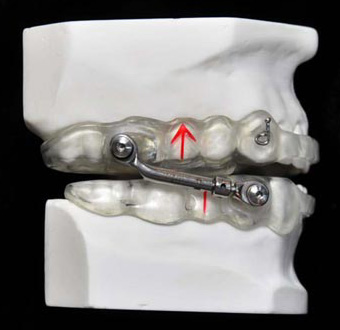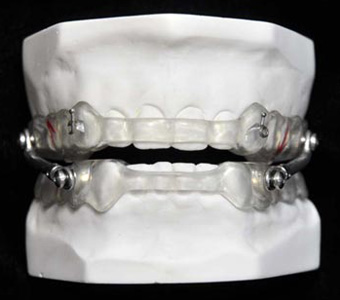
Sleep Appliance
Can't Wear CPAP Now there is an effective way to control snoring and obstructive sleep apnea without resorting to cumbersome CPAP devices. A small device, similar to an orthodontic appliance, can be an alternative to cumbersome CPAP machines and, in some cases, be the first choice for treatment of mild to moderate obstructive sleep apnea. CPAP Problems Continuous Positive Airway Pressure (CPAP) is generally considered the mainstay of treatment for obstructive sleep apnea. However, in almost half of the cases where it is prescribed, it is poorly tolerated or simply rejected due to its cumbersome and intrusive nature. Other Objections Include:
Oral Appliance Therapy Oral Appliances are placed in the mouth and are worn much like an orthodontic appliance or sports mouth protector. They are worn during sleep to prevent the collapse of the tongue and soft tissues in the back of the throat so that the airway stays open during sleep. The appliances promote adequate air intake and help to provide normal sleep in people who snore and have sleep apnea. Oral appliances can be used alone or in conjunction with other means of therapy such as continuous positive air pressure (CPAP). Determination of proper therapy can only be made by joint consultation of our office and your sleep physician. Types Of Oral Appliances Currently, over 80 different types of dental devices for snoring and sleep apnea are available to specially trained dentists to treat sleep disordered breathing. At first glance, this number appears overwhelming but on close examination each of the appliances falls basically into one of two categories and the diverse variety is simply a variation of a few major themes. Oral appliances can be classified by mode of action or design variation. Tongue Retaining Appliances There are very few tongue retaining devices available, but they have been well studied and shown to be effective in many patients. Tongue retainers function by directly holding the tongue in a forward position by means of a suction bulb that holds the tongue. When the tongue is in a forward position, the back of the tongue does not collapse during sleep and obstruct the airway in the throat. Mandibular Repositioning Appliance Mandibular repositioning appliances are by far the most common appliance on the market. They all function to reposition and maintain the lower jaw (mandible) in a protruded position during sleep. It is felt that this serves to open the airway by indirectly pulling the tongue forward since the tongue is attached to the lower jaw, by stimulating activity of the muscles in the tongue and making it more rigid, and by holding the lower jaw and other structures in a stable position to prevent opening of the mouth. Thin shells are placed over the upper and lower teeth and a device is incorporated that will pull the lower jaw forward as necessary to open the airway. Currently, there are over 80 different types of oral appliance available. Oral appliances may be used alone or in combination with other means of treating OSA, including general health and weight management, surgery or nasal continuous air pressure (CPAP). How Oral Appliances Work Oral appliances work in several ways:
By virtue of our education and training in oral appliance therapy, we are familiar with the various types and designs of appliances and can determine which one is best suited for your specific dental and medical conditions. Our office will work closely with your physician as part of the medical team in your diagnosis, treatment and on-going care. Oral appliance therapy can take from several weeks to several months to complete. Even after the initial phase of treatment is complete, we will continue to follow you to be sure that treatment remains successful and to evaluate the response of your teeth and jaws. Advantage Of Oral Appliance Therapy Oral appliance therapy has several advantages over other forms of therapy:
|
1271 East Broad St., Columbus, OH 43205 614-252-4444 |

